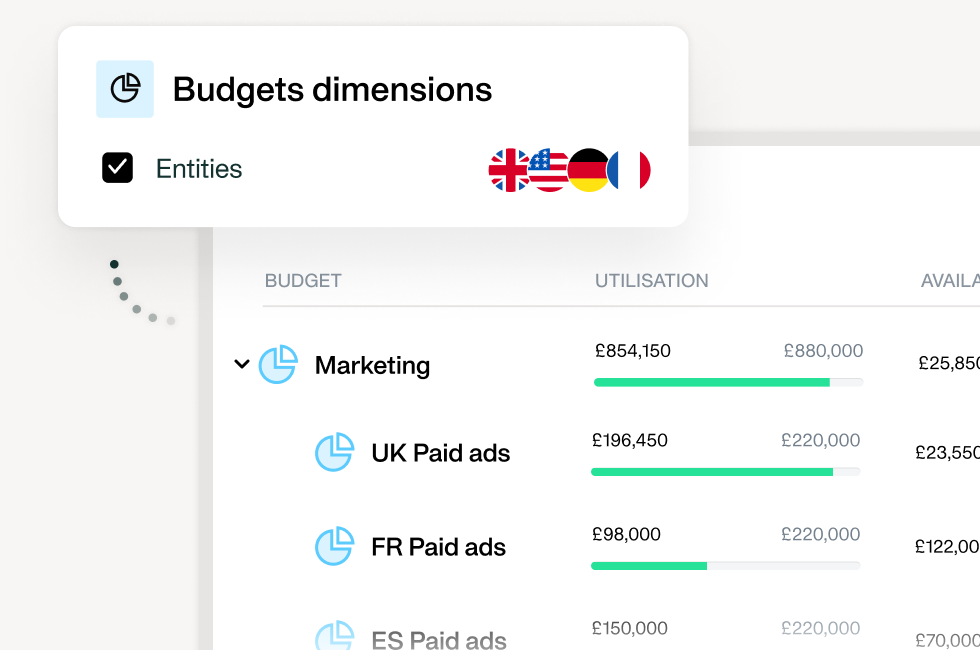
Enhancing performance: The power of multi-entity management



At Payhawk, we're revolutionising finance management with multi-entity management. Picture a world where different branches of your business merge into a single, powerful financial database. Our approach turns complex, global operations into a streamlined financial narrative, offering unparalleled insight and control over international expenditures.
By submitting this form, you agree to receive emails about our products and services per our Privacy Policy.
When it comes to managing spend, multi-entity management is also super helpful in supporting company-wide updates and automation for the finance team and beyond.
However, not all software is created equally, and you should look for specific features and benefits when selecting a solution that covers multi-entity spend management, including:
- A single view over spend and cash flow
- Cash flow control and alerts
- Highlighted missing expenses
- Streamlined invoice management processes
- Employee tracking (checking how many cardholders are onboard)
- Group level onboarding and controls
Take control of multi-entity expense management
Understanding multi-entity accounting
Multi-entity accounting and multi-entity management are crucial concepts for businesses that operate across multiple legal entities, such as subsidiaries, divisions, or branches. These concepts let companies handle the complexities of managing financial information across different units while maintaining a consolidated overview of the organisation's financial health.
Six key aspects of multi-entity accounting:
- Consolidation: Moving to a uniform multi-entity management system consolidates financial data from various entities into a unified system. This provides a comprehensive view of the organisation's financial performance and position.
- Inter-company transactions: Multi-entity accounting helps manage international business transactions effectively, ensuring that financial activities are accurately recorded and reconciled between different entities.
- Compliance and reporting: It helps comply with various regional and international accounting standards and regulations. Multi-entity accounting simplifies the process of generating consolidated reports and financial statements.
- Streamlined processes: Standardising accounting practices across entities simplifies financial processes and enhances expense management efficiency. This includes a uniform chart of accounts, consistent expense policies, and shared financial systems across multiple entities.
- Real-time financial visibility: Multi-entity accounting systems often provide real-time financial data, enabling quicker decision-making and effective management of resources across the organisation.
- Scalability: As businesses grow and expand, multi-entity accounting systems can help you scale to accommodate new entities, making them ideal for enterprise spend management.
Unlocking the power of multi-entity management
Payhawk's solution includes multi-entity spend management. The Group dashboard lets finance teams at large and growing businesses control and view their group's spending in one place. Finance professionals can check top spenders across the business, view subscriptions, reimbursements, and more, all in one screen.
The solution also supports multi-entity accounting by helping connect the dots between the spending in each entity and the data flowing into the relevant ERP or accounting software.
For a truly efficient experience, businesses will look to automate data entry via a spend management solution like Payhawk that includes company cards and OCR data capture. They will also expect this solution to integrate seamlessly with their ERP or accounting software to automate spend data flow, reduce errors, and support reconciliation.
Reduce manual effort and errors
Managing and consolidating data across multiple business entities is often manual, tedious, and error-prone.
Spend management solutions, including multi-entity management software, can help eliminate the need for manual data entry by using OCR/ AI that pulls information from multiple sources at once and automatically fills in the gaps where possible or alerts users when they need to take action on certain items. Once set up correctly, your multi-entity management system will seamlessly pull all relevant data into one place, so your data entry requirements are almost zero.
Increase transparency and visibility
Multi-entity management requires communication across all entities involved in the process. With the right software, you can increase transparency into what's happening with each entity in your portfolio.
"The Payhawk Group Dashboard allows us to monitor group-wide expenses even faster and more agile," Serkan Yüksel, Digital Transformation Finance Lead at Hypoport SE, said. "We can manage liquidity planning more efficiently and accurately through the dashboard. By breaking down the different subsidiaries, teams, and cost types, we discovered new controlling possibilities."
With more control and oversight of your data, you will get more clarity on your financial statements and make better decisions about your company's future. Access to information about all aspects of your company — not just one entity — allows you to see things in a complete picture instead of a fragmented view. This view helps with day-to-day operations such as budget management and policy adjustment but also gives you insight into long-term projects such as new product development or strategic initiatives.
Multiple entities managed in a single system
The world is constantly changing. And with rapid technological advancements, we're witnessing the transformation from a command-and-control business environment to a more agile and adaptive model.
Multi-entity management is essential to this new model as it allows different organisational functions to work together and achieve common goals. And automating multi-entity spend management data gathering enables companies to control spend, budgets, and strategies better.
With multi-entity management, Group Finance and regional teams can work together to hit their goals and make the business more efficient, joined-up, and successful.
Find out how your business could improve efficiency and strategic decision-making with multi-entity management. Book a demo today.
Trish Toovey works across the UK and US markets to craft content at Payhawk. Covering anything from ad copy to video scripting, Trish leans on a super varied background in copy and content creation for the finance, fashion, and travel industries.
Related Articles


Connected systems, better decisions: How to get multi-entity spend visibility across your business

